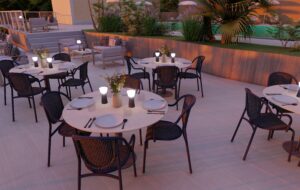|
image: Sebastiano Pellion di Persano & Giovanna Silva |
||
|
Konstantin Grcic’s radical take on the office chair chatters the ergonomists’ monopoly on workplace design and turns a bum rest into a tool, says Sam Jacob Designer chairs are strange things. We got the sitting down thing licked a number of millennia ago, so what kind of need, desire or purpose do they serve? Beyond status, fashion or technology, a chair acts as an interface between biological mechanics and culture. That’s to say, the way we sit is more like the way we talk: not natural, but a dense mixture of psychology and culture expressed through physiological means. Chairs force us to take up particular physical positions. As such we might think of them as devices manufacturing social and/or power relationships. Chairs in this sense are not things for sitting on but forces of political agency. In this vein, a chair is not an object but an action or instruction made physical. Konstantin Grcic’s 360º chair for Magis is a strange, slightly squidgy L-shaped angle, propped up on a single pole and all one colour, like an injection-moulded toy soldier. It is abstract and stylised in a way that does not seem to intend minimalist elegance (it’s kind of blocky) but in a way that makes you wonder how much of a chair it still is. The seat and backrest have become vestigial, their proportions squashed, stretched and abstracted into something just the other side of familiar. Sitting on it in a traditional way is the least successful approach – you feel a vertiginous sensation that everything that should be there isn’t. Instead, flipping the thing around and hopping on it in various positions – side saddle, backwards like an immodest Christine Keeler, propping your front up on its back, leaning into it, hanging off it – you begin to make sense of it. It asks you to find the right solution at that moment, for whatever you might be doing. It’s a chair that asks you to be decisive about how you are sitting. And it lets you manoeuvre it into a range of situations. A lever – sticking out under the body of the chair like a mechano-animalistic erection – lets you slide up and down. You can whip yourself around and around till you are dizzy. Coated all over with polyurethane, it suggests you can use any part of it for anything – arm, back and seat are whatever you want them to be. Sitting here is conceived as an active state – a constant psychological state of agitation. It’s a curious condition: uncomfortable in a comfortable way. It’s more like the way you might improvise sitting in places without seats – the park, a beach, or wherever. And somehow this provisional quality feels like a relief from a more conventionally comfortable chair. Sitting on it here in my office, it feels less like work, more like doing something. Grcic has unpicked the physio-psycho-cultural tangle that makes up a generic office chair – that combination of generic ergonomics (ergonomics: the last refuge of the clueless designer) overlaid with the comfort that comes from the cultural conception of work in the early 21st century (that clock watching, comedy email forwarding, nine-to-fiveish generic idea of work). What’s happening here is a strange trick – where by undoing the direct functional performance of the chair, Grcic makes the 360º somehow more functional. By un-inventing the normative conception of the chair, he asks its user to be party to the imaginative invention of sitting. We might think of this as a kind of inverted functionalism, an anti-ergonomics reversing traditional ideas which claim that good design is a pure expression of use. Perhaps Grcic is suggesting – in a confusion of modernist tenets – that less functionalism might strangely be more useful. In its efforts to shake off the flattened, generic experience of traditional office furniture, Grirc has made something that asks us to think of chair-as-tool, or chair-as-device. This idea is made explicit by the over-scaled protractor calibration marks moulded onto the footrest. As a tool, the chair becomes more specific. If a traditional office chair is a compromise – partly useful, partly comfortable and wholly neither – we might be better served by a range of chair-tools. You might not want a 360º for 24-7, 365. But you might find that a combination of a 360º, a Chesterfield armchair and a beanbag might equip you better.
image: Sebastiano Pellion di Persano & Giovanna Silva |
Words Sam Jacob |
|
|
||






















